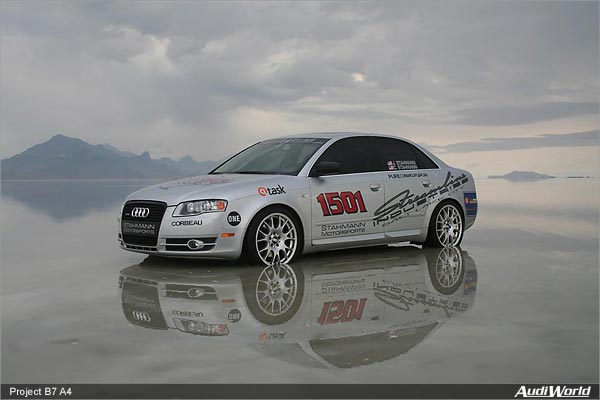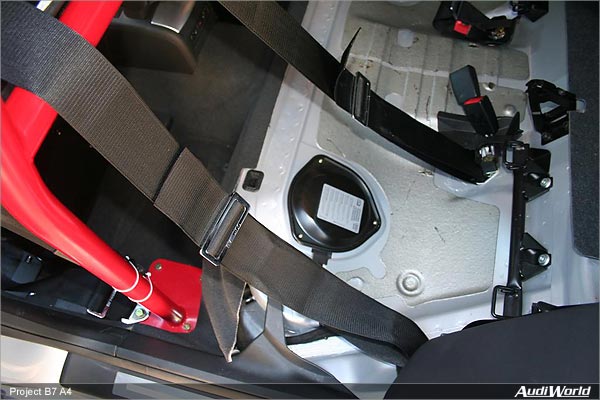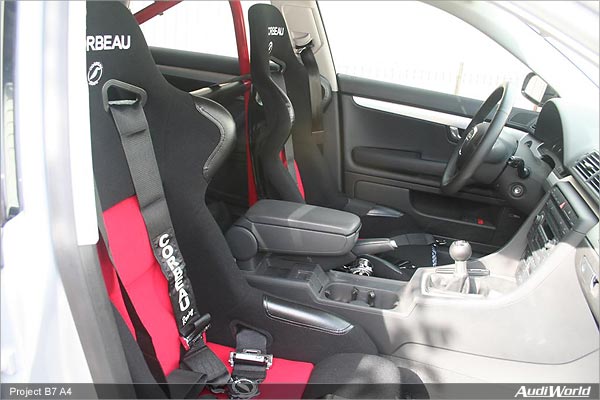Project B7 A4: Significant Performance Upgrades

Project B7 A4 has continued to develop despite the lack of regular updates. We are now taking the time to go back and document the build-out. Unfortunately some of the detailed photos have been misplaced, so this update does not include all the accompanying pictures we would have liked to provide. Instead there is a good deal of high quality photography from the 2006 World of Speed event. Suspension One of the first things that we noticed about the B7 A4 was the soft suspension. Project B7 A4 was even purchased with the optional Sport Suspension, but in reality the sport suspension falls to the softer side of suspensions. Since the car is driven daily we didn’t want to go all the way to a track setup, but we also wanted the ability to quickly go to a track setup and to adjust the stance of the car. After considering the various options that were available for both spring/shock and coilovers, we decided to go with the Vogtland coilovers from Pure Motorsport. The Vogtland Coilovers provide a good sporty suspension for the A4, with adjustable height front and rear. We have been fortunate this summer to spend quite a bit of time behind the seat of the Project B7 A4 on its home track at the Miller Motorsports Park, and are extremely happy with the suspension setup so far. We haven’t made any modifications to the sway bar setup on the A4, but we may consider this in a future installment. Intake and Exhaust In our previous installment, the Project B7 A4 ECU was upgraded with the APR programming to provide extra power and better driveability. From the factory, the air intake and filter system is designed to both filter the intake air as well as provide sound deadening to help isolate intake noise from the occupants of the vehicle. One could argue that the stock airbox setup is not very efficient at its real overall purpose – providing enough air to the engine for the desired performance. By the same token, the stock exhaust system is designed to maintain low sound levels, but is not optimized for the most efficient flow of exhaust gasses. To take advantage of the full performance potiential of the 2.0 T engine we want to optimize both the intake and exhaust. We picked the Carbonio Cold Air Intake system for the 2.0T for several reasons. It is designed to increase horsepower by providing more air to the engine, isolate the intake air from the under hood heat generated by the engine and also lets you hear more of the intake sound from the engine – a feature that comes down to personal preference (but in our opinion a plus). The Carbonio Cold Air Intake system main section is made from carbon fiber, so it isn’t as affected by under-hood heat and it really has a great look too. Installation of the Carbonio Cold Air Intake system was extremely easy. Excellent instructions come with the kit and installation took less than a hour total. The APR exhaust was chosen to compliment the other APR components that are being planned for the Project B7 A4. The APR cat-back exhaust system provides a deep, throaty sound that’s not too loud and also doesn’t drone at freeway speeds. The APR exhaust system is made from 2.5″ mandrel bent stainless steel in the front section, with dual 2.25″ pipes to the rear mufflers. APR has specific programs that are tuned to this exhaust and its flow characteristics, so it makes sense for us to use the APR exhaust system – especially as we plan to integrate more APR components into the drivetrain of the Project B7 A4. The combination of the Carbonio Cold Air Intake and the APR exhaust system gave the Project B7 A4 increased throttle response, as well as more power. Especially under acceleration, the 2.0T doesn’t feel like it’s struggling to breathe as it did before installation. Also, the sounds from the intake and the deeper exhaust tone add to the overall driving experience. More Power While we were extremely pleased with the power provided by the APR chip, Carbonio Intake, and APR exhaust system, we have had experience in the past with the extra power provided by putting a K04 turbo on the 1.8T powerplant, and were excited about the K04 kit developed by APR. Since we were preparing the Project B7 A4 for the World of Speed at the Bonneville Salt Flats we knew that the extra power would come in handy. APR’s K04 kit includes everything needed to install the kit onto the 2.0T engine except the labor, and for that we turned to a local Audi/VW tuning shop in Salt Lake City – Streamline Industries. Streamline has a reputation in Salt Lake City as the go-to shop for VW and Audi performance. Once the APR K04 kit was installed the ECU had to be re-flashed to upgrade the programming to take advantage of the new K04 turbo. We were impressed by the immediate jump in power after installing the turbo kit – the car was noticeably more powerful with a torque curve reminiscent of a chipped B5 S4. We also noticed that power was available all the way to redline, and didn’t seem to taper off as in a K03 equipped 2.0T. With the K04 the car just pulls and pulls and pulls. We feel that the APR K04 turbo kit puts an A4 squarely in B7 S4 territory, although we haven’t had the chance to go head-to-head with one yet. According to APR dyno charts, the Project B7 A4 should be putting out 298 hp/321 lb-ft now. We can really feel it!
Roll Bar As we were preparing the project B7 A4 for an attempt on the 150 Club at the World of Speed at the Bonneville Salt Flats, we need to meet specific requirements. One of those requirements is to have a 4-point roll bar installed in the car. We had a custom shop build a 4 point roll bar for the 2000 S4 that we had owned previously, and when we test-fit the roll bar in the Project B7 A4 we found that the bar fit perfectly. We had to
Seats and Harness Belts Another of the requirements to make an attempt for the 150 Club at the World of Speed is that the vehicle be equipped with at least 4-point seat belts. We were also looking to reduce weight as well as provide more support for our occasional track days, so replacing the driver and passenger seats is in order. In researching potential seats for the Project B7 A4, we were introduced to Spencer Bond of Corbeau USA. Spencer invited us to the Corbeau USA headquarters to sample their complete line of seats – from their top of the line reclining back seats to their fixed-back racing seats. We even tried out their Baja Off-Road seats for the AudiWorld Project Jeep TJ… Ooops! When it came down to racing seats for the Audi, there were two seats that Spencer suggested to us – the Corbeau FX1 and the Corbeau FORZA. The main difference between the two was that the Corbeau Forza has a tubular steel frame, while the Corbeau FX1 is made out of molded fiberglass. To us, the Corbeau FX1 was a more comfortable seat, as well as being slightly lighter than the Forza. The Corbeau FX1 seat inserts are removable and are available in multiple colors, so we got both black and red seat inserts so we could mix and match the colors to our liking. Corbeau also sells racing harness belts. We selected the Corbeau 3″ Competition Harness System. It’s a 5 point harness belt and carries an SFI rating of 16.1, which complies with the belt requirements for the higher speeds at Bonneville. The Corbeau harness belts also feature the preferred cam-lock locking system for the belts. For installation we secured the two shoulder straps to the rear belt factory mounts, the crotch strap to the seat mounting, but ultimately had to drill through the floorboard of the A4 to secure the two lap belts. As is recommended, we used 1/4″ steel mounting plates below the car where the holes were drilled. The floorboards of the A4 are surprisingly thin and to ensure safety we needed to use the plates to prevent the bolts from pulling through the floorboard in the event of a crash. |


